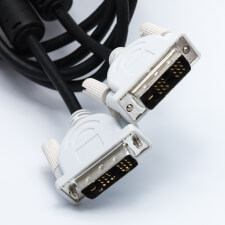DVI
Stands for "Digital Visual Interface."
DVI is a video interface used to connect monitors, projectors, and other display devices to a computer. It supports both analog and digital video signals over a single connector, although some variant connectors only supply one or the other. DVI was a common display interface in the 2000s and 2010s. It replaced the older analog-only VGA interface and was itself replaced in the mid-2010s by HDMI and DisplayPort.
The DVI interface was the first mainstream video interface that could transmit a purely digital video signal. Previous interfaces, like VGA, first converted the digital video signal to an analog signal and sent that signal over a cable. However, analog video signals are susceptible to electrical interference that could affect image quality. By supporting both analog and digital video signals, the DVI interface allowed computer users to use either an analog CRT monitor or a digital LCD monitor through the same port on their graphics card.
The DVI interface used several types of connectors that used different pin layouts to carry video signals:
- DVI-A carries only an analog video signal, which can be converted to a VGA connection using a passive adapter.
- DVI-D transmits only a digital video signal. There are two subtypes of DVI-D connectors, single-link and dual-link, with dual-link offering more bandwidth to support higher resolutions and refresh rates.
- DVI-I carries both an analog and a digital video signal, allowing a computer to connect to either type of display using the same connector. Like DVI-D, DVI-I is available in single-link and dual-link versions, although only the digital signal benefits from the additional bandwidth. Like DVI-A, its video signal can be converted to a VGA signal using a passive adapter.
By the 2010s, analog CRT monitors were no longer widely used, and the ability to transmit an analog video signal was unnecessary. Newer interfaces like HDMI and DisplayPort provide purely digital video signals while also including audio. DisplayPort can also carry USB data to allow a monitor to include a built-in USB hub. HDMI and DisplayPort are capable of higher resolutions and refresh rates than DVI, leading to DVI becoming an obsolete interface.
 Test Your Knowledge
Test Your Knowledge